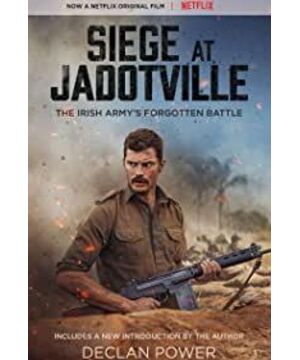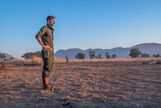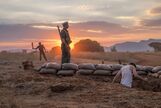Originally published in the 28th issue of "Watching Movies Weekly" in 2016, it is limited to the length of the magazine, and I always feel that it has not been explained thoroughly, and it is quite unsatisfactory. At the same time, film magazines have instructions such as "Don't always criticize Chinese-made films", so some of the contents of this manuscript have been removed from the officially published version:
If the rise of Poland, Estonia, and Denmark in the international war movie market in recent years is truly amazing, then the appearance of the 2016 Irish war movie "Siege of Yadauville" is simply amazing—Ireland as a neutral country , Actually produced a war movie. Probably because of the "blood" of a neutral country, this movie is somewhat unknown. However, for Ireland, which has very good production funding and experience in shooting war films, it is already commendable to be able to shoot such war films.
Background cloud wave weird
In war films with the theme of World War II, the dualistic battle between good and evil is very helpful for the audience to understand the camps or "moral tendencies" of the two sides. In contrast, during the Cold War period during the confrontation between the United States and the Soviet Union, the environment of international relations seemed treacherous. Chinese viewers probably don’t understand the relationship between the various forces that appeared in "Siege of Yadauville"-the United Nations, the United States, the Soviet Union, France, Ireland, Congo and the independent province of Katanga. .
The Congo in Africa was originally a colony of Belgium. In 1960, Congo became independent under the leadership of Patrice Lumumba, chairman of the Congolese National Movement Party. However, Belgium instigated the "Katanga Tribal Alliance", a political force in the province of Katanga in southern Congo. Its chairman and warlord Moiz Tshombe declared the independence of Katanga province as the "Republic of Katanga." Lumumba asked the United Nations for help. However, Western countries have always regarded the Congo, which is rich in strategic resources, as their sphere of influence. Therefore, while organizing the United Nations troops to go to peacekeeping, they also secretly sent some military personnel to Canada as mercenaries. Danga Province, supports the independence of the "Katanga Republic". After Lumumba expressed his intention to move closer to the Soviet Union, the United States, France, and Belgium jointly planned a coup in the Congo. In the movie, US President Kennedy and French President Charles de Gaulle also all appeared. In the end, Colonel Mobutu Seko, the chief of staff of the Congolese National Army, launched a coup and overthrew Lumumba and handed it over to Thombe’s rebels for killing. It is against this background that the French mercenary leader Colonel Roger Falques led a rebel army composed of French mercenaries, Belgian expatriates and Congolese Luba tribesmen, to the United Nations troops stationed in the Irish Capitol in Yadauville. 35th Infantry Battalion A Company launched an offensive. The siege of Jadauville in the movie began.
In this situation, Western countries headed by the United States have adopted two split attitudes towards the Congo crisis. Morally, they can only approve and organize and lead the UN troops to peacekeeping. In terms of interests, they even hope that the Congo will maintain its colonial rule and treat it passively and secretly undermine the UN peacekeeping.
A small fight is also wonderful
From the perspective of military strength, this battle was just a "small fight". In the Battle of Yadauville, there were only 158 people in the A company of the Ai Army. Different documents have different descriptions of the strength of the Congolese rebels, ranging from 300 to 3,000 to 5,000. The Congolese rebels have an absolute advantage.
Nowadays, many war films in China have begun to imitate the West, pursuing grand scenes or "realistic" battlefield effects, and even imitating subjective shots like "Saving Private Ryan". However, the setting of weapons, equipment, props and military details is still contrary to historical facts and shoddy. In contrast, the low-cost "Siege of Yadoville" restored the battle as much as possible, and the props were also very sophisticated, which really formed a sharp contrast.
In the movie, the battle between the two sides is dominated by light weapons. The Armaments of the Irish Army include the Belgian "Browning" 9mm high-power pistol, the FN FAL 7.62mm automatic rifle, the Swedish M/45 "Karl Gustaf" 9mm submachine gun, and the British "Lee-En "Field" No.4 Mk 1 type 7.7mm rifle, "Lee Enfield" No.4 Mk 1(T) type 7.7mm sniper rifle, "Bren" Mk 1 type 7.7mm light machine gun, "Vickers" type 7.7mm heavy machine gun, American Mk 2 grenade and M2 60mm mortar, and an American UH-1 "Huey" multi-purpose helicopter was sent from the rear. The light weapons of the Congolese rebels, including the German P-38 "Walter" 9mm pistol, the K98k "Mauser" 7.92mm rifle, the Belgian "Browning" 9mm high-power pistol, and the FN FAL 7.62mm automatic rifle , FN MAG 58 type 7.62 mm general machine gun, French MAT-49 type 9 mm submachine gun, American M1919A4 "Browning" type 7.62 mm heavy machine gun, M2HB type 12.7 mm heavy machine gun, Soviet Dshk type 12.7 mm heavy machine gun, Sweden M48" Carl Gustaf" 84mm rocket launcher and British ML 76.2mm mortar. In real history, the Congolese rebels are equipped with multiple 81mm mortars and a French M1897 75mm field gun. Of course, the Congolese rebels also have an advantage that the Irish army simply does not possess-a French MC.170 "teacher" trainer, used as air support.
The movie truly reproduces this mythical defense battle. In the absence of assistance and no heavy fire support, the 158 officers and soldiers of the Irish army without any actual combat experience, with light weapons mostly of the technical level of the Second World War, withstood the Congolese rebels with heavy fire support for 5 consecutive days. Siege. After the mountains and rivers were exhausted, and the ammunition and food were exhausted, the Ai Army was forced to surrender, but only paid the price of 5 wounded. In contrast, the Congolese rebels, which had an absolute advantage in number and firepower, had more than 300 people killed, including 30 French mercenary veterans with Algerian war experience, and more than 1,000 wounded. Such a disparate casualty and loss ratio can be called a myth in the history of war. At a critical juncture, the Army even thought of using explosives to detonate a wooden box filled with empty bullet shells as a creative tactic for bombs. This is also the source of the tragic phrase "We have used each bullet twice" by Pat Quinlan, the commander of Company A. In the movie, the Irish mortars used magic artillery to destroy the Congolese rebel mortar positions behind the woods. This kind of plot, which seems to be only in the "Anti-Japanese Drama", happened in the real Siege of Yadauville.
Of course, there are some settings in the movie, which may be controversial. For example, the MC.170 "teacher" trainer of the Congolese rebels fired, but the role of the Irish army can survive in two ballistics. This probability is too small. When sniping and killing the "white suit boss" of the Congolese rebels at a long distance, the Irish snipers replaced the "Lee Enfield" No.4 Mk 1 (T) with "Bren" and only loaded 1 bullet. And use the ruler and sight to aim. In theory, the former is better than the latter regardless of the maximum range or the effective range. In any case, for shooting long-distance point targets, the effect of a sniper rifle should be better than that of a light machine gun, and the accuracy of a sniper scope is better than that of a ruler and a sight. Many foreign military enthusiasts are also suspicious or puzzled by this setting in the movie. The only explanation is that the sniper is to use the "Bren" two-leg bracket to obtain better stability, so as to achieve the effect of precise sniper killing. Many "Bren" shooters in the British army also praised this light machine gun as "the best automatic sniper rifle in the world."
How to talk about feelings with perfunctory attitude ?
The success of "Siege of Yadoville" is a victory of attitude. There is neither fanfare nor high cost, and it is not even well-known, but its appreciable degree is no less than that of "Boom Shell" "13 Hours of Crisis", which is enough to rank among the 2016 world war movies. The forefront of the list. Compared with the war films in China that frequently "invest 150 million", it is even more "I don't know where the height is." As a low-cost war film, the entire crew has tried their best to "restore history" to the extreme.
Since "Saving Private Ryan", subjective shots from the perspective of the soldiers participating in the war have almost become the standard configuration of contemporary war films. Chinese war films took over the banner of the "cottage" style uncompromisingly, and subjective shots were flooded. Some movies even "creatively" invented the "reversed subjective lens"-instead of aiming the subjective lens in the direction of the muzzle, the lens was fixed on the muzzle and aimed at the gunholder in the opposite direction. This kind of perspective without any sense of substitution, I don't know what kind of experience the audience wants to have. In contrast, the camera used in "Siege of Yadauville" is very traditional. Only scenes that show the commander looking out with a telescope or aiming with a sniper use a small amount of fleeting subjective shots. However, the compactness and tension of the movie's plot and the sense of substitution of the battlefield environment are not inferior.
"Siege of Yadauville" is low-cost, but its weapons and equipment are unambiguous. Some Chinese movies claim to have "invested 150 million", but they made tanks whose turrets would not turn, bombers with false CG effects, and 12.7mm heavy machine gun bullets that hit human limbs and only produced a small bullet hole. Some directors even said that "the model of the plane and tank is not important, only feelings can move the audience." He refuses to respect even the basic historical facts, he refuses to make good props, and he still talks about "feelings" with such a non-serious attitude. Isn't this more ridiculous than the arrogant invaders back then? In order to enhance the so-called dramatic effect of the movie, the Chinese war film market is already a gathering place for various "original dramas." "Fake" word? As everyone knows, true history is far more exciting than making up without logic or disregarding reality. As a country that has never had a foreign war since its independence in 1922, Ireland can still unearth such legendary shining points from history, but today’s Chinese war films can only show China’s five thousand years of drama The history of internal and external warfare is really dumbfounding.
In "Siege of Yadauville", the predicament of the 158 officers and soldiers of the Irish army created a world for the Irish war film. Certain Chinese war films can only rely on catering to fanatical nationalism and peddling "feelings", which is really disgusting. This is worthy of profound reflection on the entire Chinese war film market.
View more about The Siege of Jadotville reviews











